
When firefighters arrive on the scene of a structure fire, one of the first tasks they have to accomplish is stretching an attack line. The building’s size, shape, and height will be the determining factors in what kind of stretch they use. There’s an old adage that says, “The fire will go as the first line goes.” In other words, if the attack line is stretched in a poor manner, the firefight will not go as planned because a poor stretch leads to other problems and those problems will compound and lead to more chaos.
RELATED
A Guide to Selecting the Attack Line
The Second Line: A Backup Line or a Second Attack Line
Training Minutes: Moving the Attack Line
First-Arriving Engine: A Progressive Fire Attack Plan
Several methods of stretching a hoseline are outlined in the following paragraphs. Although you may not use all of them every day, I promise you there are buildings in your district where any of these hose stretches will work. You must get out in your district and determine which method would be best for a particular building and train on it.
Sizing Up the Hose Stretch: DOSE
Get in the habit of sizing up the hose stretch. We size up everything in the fire service—construction, smoke and fire conditions, roofs, and doors. Yes, stretching hose should be sized up also. When stretching an attack line, first look at several factors. I’m not a big fan of acronyms in the fire service, but one I do like to use in the classroom when discussing sizing up the stretch is DOSE: Distance, Obstacles, Stairs, and Elevation.
Distance. There is no reason to put your hands on any hose load until you know how far your stretch is and how much distance you’ll have to cover. This includes from the rig to the drop point and from the drop point throughout the entire building and enough hose to cover the fire room. There are several methods for determining the length of a hose stretch, but I will not discuss them here. The art of estimating the stretch, I believe, has been put on the back burner because many firefighters rely solely on preconnected hoselines. A versatile rig set up with various lengths of hoselines or a bulk bed, plus learning to estimate the stretch, will prevent two of the most common hose stretch problems, stretching short and stretching long.
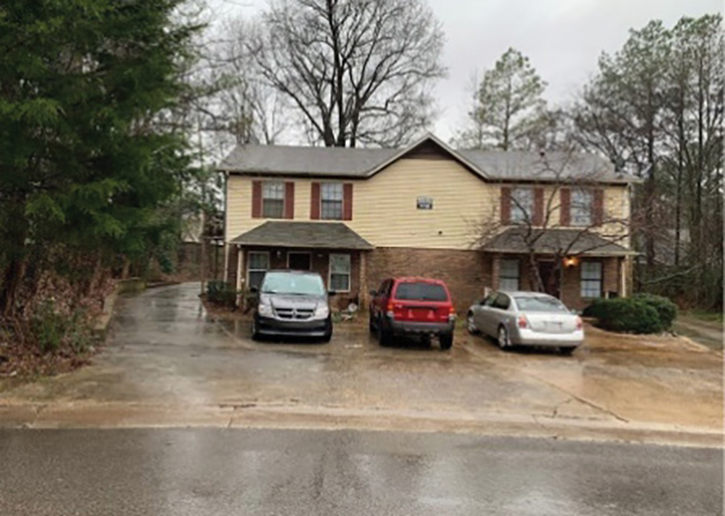
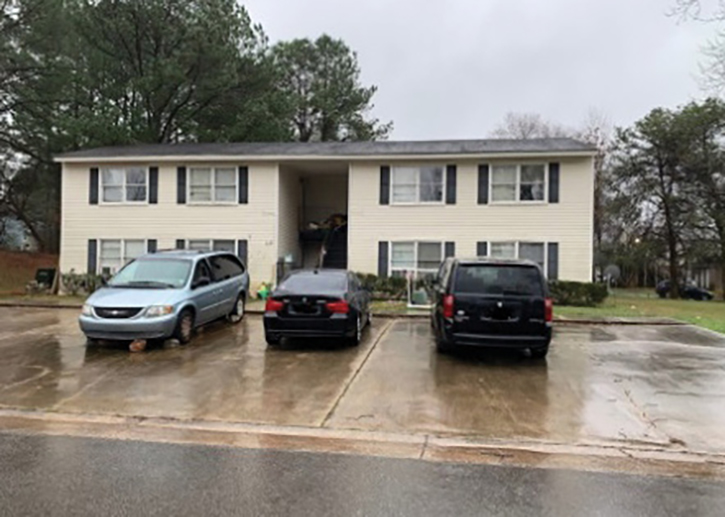
(1-2) These cars would be obstacles if we had to stage the hoseline at this apartment door in our first-due district. (Photos by author unless otherwise noted.)
Obstacles. An obstacle is anything that affects how you navigate with your hoseline; it could be cars, landscaping, fencing, or anything else. It seems that vehicle tires are hose magnets because the hose will snag at the pinch point between the tire and the pavement easily if the turn is not overexaggerated or managed by a backup firefighter. You have to ask yourself, “What is in the path of the stretch, and are there any alternative means of stretching the attack line that would be faster, easier, and more efficient?” The faster we stretch, the faster we get water; the faster we get water on the fire, the better off we will be in protecting civilians and saving property. You can eliminate some of these obstacles and distance by stretching vertically, which will be discussed. You can also figure out most of your fixed obstacles during preplanning and getting out in your district. What to do about other obstacles, such as cars, will have to be determined once you arrive on scene.
Certain hose loads, such as minuteman or modified minuteman, are more conducive for navigating obstacles and stairs because the hose load is loaded on the apparatus with the nozzle on the bottom and the remainder of the hose loaded on top of it. This allows firefighters to get the hose load on their shoulder with the nozzle down, which will allow the remainder of the hose to play off the top, as needed, around obstacles and corners, up a set of stairs, and around turns at landings. Remember that anytime you are dragging hose on the ground, it will snag on various obstacles, making the stretch harder to manage. If you use a hose load such as a flat load or a modified flat load, the firefighters can flip the nozzle side of the hose load over as they slide it out to shoulder it. This puts the nozzle on the bottom, creating a minuteman load from a flat load and improvising.
Stairs. There are different forms of stairs. They can be constructed as return stairs, scissor stairs, or access stairs, for example. Stairs can be the sole deciding factor in what type of stretch you might use at any given occupancy. Most firefighters see stairs as a hindrance to their hose stretch; but, if you learn your stretch types and broaden your horizon, you will see that stairs can be handled easily and can afford you several opportunities when it comes to stretching hose. Stairs and stretch type options to use with them are discussed later. The key is to size up the stairs and preplan. If you choose to stretch hose up the stairs, be sure the nozzleman slows down and allows the backup firefighter to assist with the stretch and ensure the line is laid out properly as you ascend.


(3-4) Madison crews working in their first due at a garden apartment on stretching handlines to navigate the stairs and stage the hose on the second-floor breezeway with the working length at the door.
Elevation (or deelevation). This could be considered elevation on the ground or elevation in a building such as a mid- or a high-rise with a standpipe system. If you are stretching hose up a hill, you will use more hose than you would on flat ground, and if you’re stretching hose downhill, you will use less hose. A house or a building on a hill could cause you to stretch short if you don’t take the time to estimate the stretch because uphill slopes appear to be shorter and downhill slopes appear to be longer. This is where made-to-order hose stretches from a bulk bed or having a preconnect long line can make or break the first line getting into position and operating fast. In regard to elevation in buildings, such as a high-rise, you would more than likely stretch hose using high-rise packs connected to the building’s standpipe system and follow the local standard operating procedures with regard to fighting fires in those buildings.
Types of Hose Stretches
The Straight Stretch
The straight stretch is fairly obvious. The attack line is stretched from the rig to the door in a rather straight manner. This is the most common stretch type in the American fire service. The hose is removed from the apparatus and stretched from the rig to the drop point, waiting to be charged. Although there might be some obstacles to navigate, such as cars or landscaping or a set of stairs up to the second-floor breezeway of a garden apartment, the hose stretch does not require any tools or techniques outside of stretching from one point to another. The end goal is to get your hoseline as in line with your entry point as possible and get the working length of hose near the door before charging the line. The working length of hose is the nozzle and the first 50 feet of hose. So, your goal is to get the nozzle and the first coupling near your entry point.
When operating in a multiple dwelling or a center hallway occupancy, you won’t be able to get the hose as in line with the entry point as possible like you would at a single-family dwelling. When confronted with this situation, stage the nozzle and the first 50 feet of hose behind it to the hinge side of the fire apartment’s door because in most multiple dwellings, the door from the public hallway opens and swings toward the party wall that divides that room from the adjoining unit. This will facilitate a smoother advance and also allow the nozzle firefighter to begin to attack the fire as soon as the door is being opened, if needed, even if it’s just a few inches, whereas a hoseline staged to the latch side will mean the nozzle firefighter will have to wait for the door to be opened almost completely before being able to attack the fire.
The Barber Stretch
The barber stretch is used when navigating stairs. There are various forms of stairs; some have what’s known as a well hole. In cases of navigating hose up a set of stairs without a well hole, the firefighter walks up the stairs to a landing, turns and goes up another set of stairs to a landing, and so on, until reaching the floor or area where the hoseline will be staged; then, he calls for water. It is named after a barber’s pole because of its blue and red lines that spin around and around outside of a barber’s shop. This method of stretching uses more hose than a well-hole stretch. You will see why when we discuss the well-hole stretch later. When you consider the setback of your apparatus to the building and the length of hose needed to ascend the stairs, cover the fire building, and the fire room, you’ll find that a 200-foot preconnect might not get you very far and may lead to a short stretch.
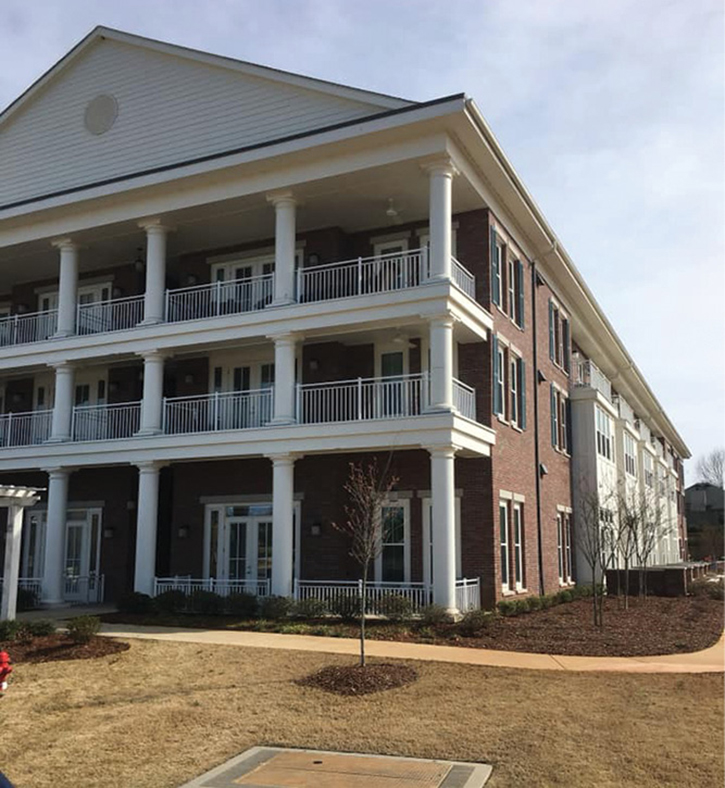

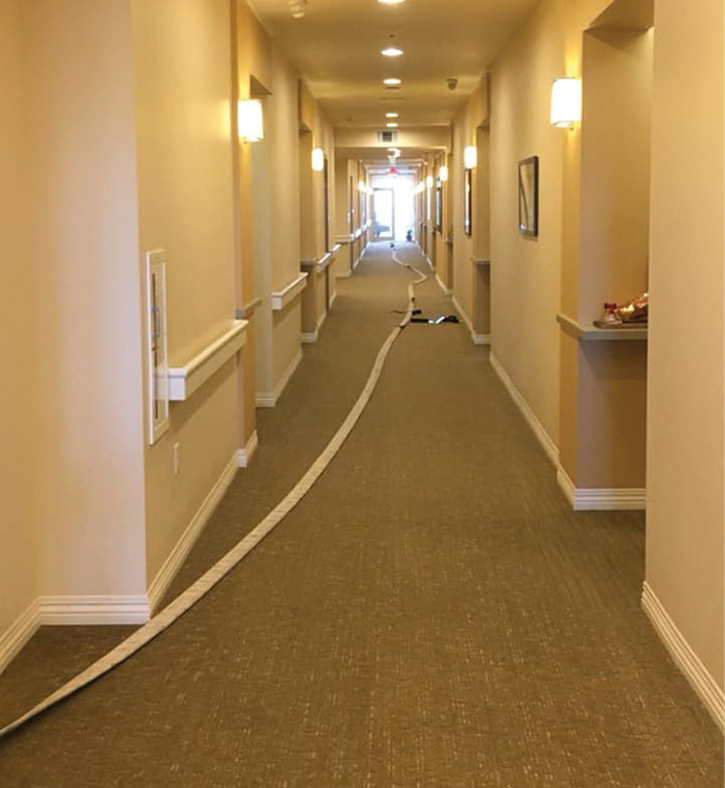
(5-7) Madison crews from C-shift, Station 2 practice stretching the 350-foot hoseline in a center hallway of an assisted-living facility. In this drill, the hoseline was barber stretched through a door and up a stairwell to the third floor. The nozzle made it to the last apartment in the longest hallway. A vertical stretch over the front balcony would allow for a longer stretch and could be a faster option with training.
The Vertical Stretch
A vertical stretch can save you a lot of hose and time when you have trained on it and execute it correctly. It can be used anywhere: hotels, low- to mid-rises, apartment complexes, tenement housing, condominiums, hospitals, or anywhere that the elevation and stairs would prevent your hose length options from reaching the fire area. A vertical stretch involves stretching hose along the side of a building to go through a window, over balconies, or to an outside stairwell. This is also a very effective way of getting the first hoseline in position at fires in parking garages.
Some departments use an aerial as an elevated point to attach their hose and begin a fire attack instead of using a vertical hose stretch. Although this seems like a good plan, there are several problems with it. First, it can be time consuming to set up an aerial apparatus, position it, attach hose, stage the line, and charge it. We know time is not on our side. Second, and a bigger problem, is that once the fire hose is attached to the tip of the aerial, the aerial can no longer be used for other tasks such as an aerial master stream, navigating to windows to remove civilians, or accessing exposure rooms for searches. You can use the aerial to carry hose up to a given location; but once you get there, throw the hose off the side. This frees the aerial for the other tasks mentioned above.
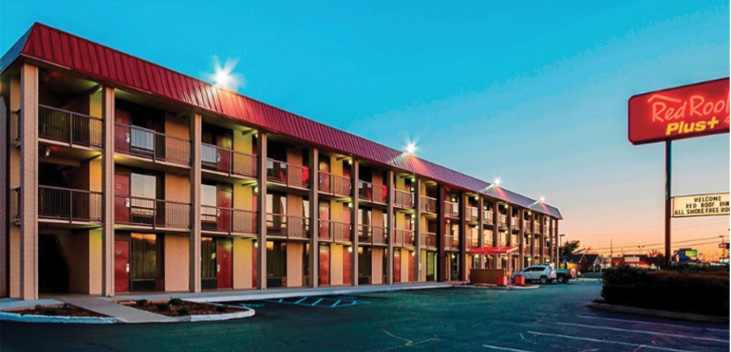
(8) This commercial building has stairwells on both ends and no well hole. A viable option that would use less hose would be stretching vertically over the railings, lowering or hoisting a hoseline, instead of barber stretching up and around the stairs and then down to the fire room.
There are two ways to get hose where you need it when stretching vertically: lowering it and hoisting it. If you’re lowering it, a firefighter would carry a hose bundle up and open a window; go to a balcony or an outside stairwell; and lower hose to another hose of like size, a leader line using an appliance or a nozzle shutoff.
When connecting hose to any appliance or shutoff, ensure the valve to that appliance is secured in the open position to prevent it from closing. If you do not have a way to secure it open, you must staff it with a control firefighter. The firefighters on the higher areas can hoist the hose using a number of options, which will be discussed with the following hose stretch options.
The Well-Hole Stretch
The well-hole stretch uses less hose, keeps control of water delivery within your equipment and apparatus, and keeps the stairways open for other crews operating on scene and traveling the stairs. It also keeps water delivery within your apparatus and equipment because you’re stretching from the rig to the upper floor, bypassing the standpipe system. Always use your equipment that you check on a daily basis whenever possible.


(9) A well-hole stretch to the fourth floor of a center hallway in an extended stay hotel. (10) A 1¾-inch handline is extended off a 2½-inch shutoff. The bail is secured in the open position by way of a self-fastening strap from the hose bundle.
A well hole is the hole created in the middle of the stairs as they go up in a building. The width of the well hole can vary from a few inches to several feet. First, size up the well hole to determine if its width can handle the hose size you’re using. In most cases for 2½-inch hose, you can stick a gloved fist in the well hole; if your gloved hand fits, the line will fit. To carry this out, the first firefighter should keep the working length of hose on his shoulder, slide the hose in the well hole, and begin ascending. The backup firefighters should ensure the hose stays in the well hole and assist in managing the hose as they ascend the stairs, keeping the hose tight.

(11) The correct and incorrect way of stretching a second hoseline up a well hole to prevent hose twist. (Photo by Anthony Rowett.)
The advantages of using the well hole instead of barber stretching the stairs are that you use less hose and it is faster. We discussed earlier how far a 50-foot section of hose would go during a barber stretch, but with a well hole, a section of hose would cover four to five stories since floor heights in commercial buildings usually run between 10 and 12 feet. In photo 6, my crew and I practiced stretching hose on a four-story extended-stay center hallway hotel. It has a smaller well hole, as you can see, and it’s just wide enough to accommodate our 2½-inch attack line. We were able to determine that our 200-foot 2½-inch preconnect would stretch to the top floor and cover more than halfway down that hallway. So, depending on which end of the building the fire was reported or is visible would determine which stairwell you would use so you could make the fire apartment.
There is one thing to take note of during a well-hole stretch with regard to a second line being stretched. If the second line is stretched the same way as the first, the second hoseline will wrap around the first one in a spiral as the firefighter ascends. To avoid this, the firefighters stretching the second line should slide the hoseline in the well hole and just carry the nozzle up. When they reach each stairway landing, the firefighter with the nozzle passes the nozzle around the first hoseline. This will prevent twisting and eliminate any problems as they ascend. In a well-hole stretch, it is also paramount that you secure the hose to the top of the railing once you’ve made your floor choice. I keep a small section of webbing with a carabiner in my gear that I use for a multitude of things; this is one of them.
The Rope Stretch
A rope stretch (also known as a bottle stretch) involves using a piece of rope or personal webbing to lower to the ground and allow a firefighter below to prepare your hose to be hoisted. In some cases, fire departments have on their rig a bottle filled with smaller-diameter rope that can be carried to an upper area. Then, a firefighter would secure the rope and throw the bottle over the side to the ground. Other fire departments issue personal rope bags to their firefighters or their firefighters carry their own personal rope bag that can be used in these situations. In most cases, the terms rope stretch, bottle stretch, and bag drop are used interchangeably; the terminology is usually dictated by the department or region of the country.
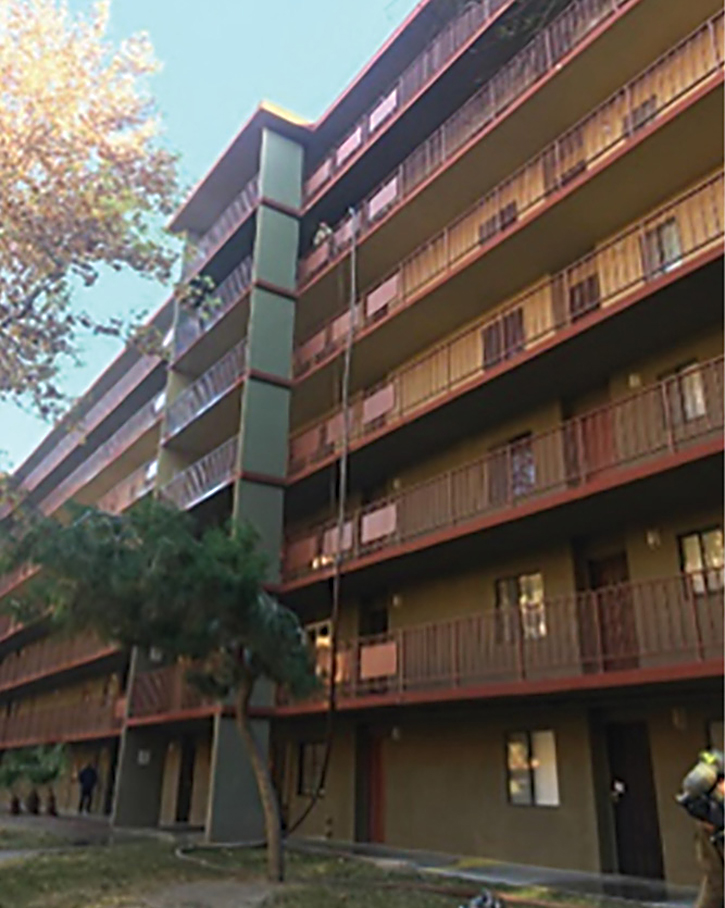

(12) The Clark County (NV) Fire Department uses what it calls a “bag drop” to stretch an attack line to the sixth floor of an apartment building with a fire. (Photo by Ward Symes.) (13) A pike pole is used to hoist the hoseline by hooking the nozzle’s bail with the pike pole. This vertical stretch method allowed the 200-foot preconnect to go farther than it would if it were barber stretched. (Photo by Patrick Mackay.)
The Hook Stretch
A hook stretch is used when you’re covering only a floor or two. A firefighter carries a hook, such as a pike pole, New York roof hook, or trash hook up to the fire floor and holds it over the railing. The firefighter on the ground hooks the bail of the nozzle onto the hook’s point and the firefighter pulls it up to his location or continues to push the handle up to the floor above him to another firefighter waiting to grab the pole and pull up the hoseline. This can be a quick method; but, in my opinion, webbing can be just as fast or faster for short distances, or select a different stretch such as a barber stretch. I like to slide a bight of hose near the 50-foot coupling through the bail of the nozzle and hook it instead of just the nozzle. This ensures that when the firefighter receives the nozzle, he is also receiving the working length of hose.
If you’re using any of these methods on an outside porch or balcony that has railings with a gap between the bottom of the railing and the floor, load the deck with 100 feet of hose and stand on it with your feet, or stand between the hose and the railing when you call for the line to be charged. This will prevent the hoseline from “jumping” when it’s being charged and sliding through the gap and being pulled down to the ground because of the weight of the water. If you choose to go over the railings, use the small piece of webbing and a carabiner during the well-hole stretch to girth hitch the hose and secure it to the balcony so the water weight doesn’t pull it down during operations. But remember, securing the hose prevents the hose from going down, but it also prevents it from going forward, so make sure you have an adequate amount of hose at your drop point before securing the hose so you have enough hose to cover the fire building or room of origin.
You can see that stretching hose is an art and there are multiple of ways to do so. You wouldn’t arrive on scene to a single-story ranch home and perform a vertical stretch, but you also wouldn’t arrive on scene to a fire on the fourth floor of a center-hallway apartment building and expect a barber stretch up the stairs and through multiple doorways to be your shortest, fastest, and most effective option. You must practice every one of these hose stretches and get out in your district to preplan which buildings would require which stretch. Once your crew has decided on options for those buildings, practice stretching the hoselines, and time each stretch. The stopwatch will never lie and can be a good tool for setting benchmarks for your crew and establishing accurate and expected time frames for getting a hoseline stretched and operating in a particular building and on a particular floor.
CHAD MENARD is a 16-year veteran of the fire service and a captain/paramedic in Madison (AL) Fire & Rescue. He’s worked in suburban America from the volunteer and career sides. He has a bachelor’s degree in fire services administration and is a graduate of the Managing Officer Program. He is a credentialed fire officer through the Center for Public Safety Excellence. He is the owner of First In Fire Training, LLC.

